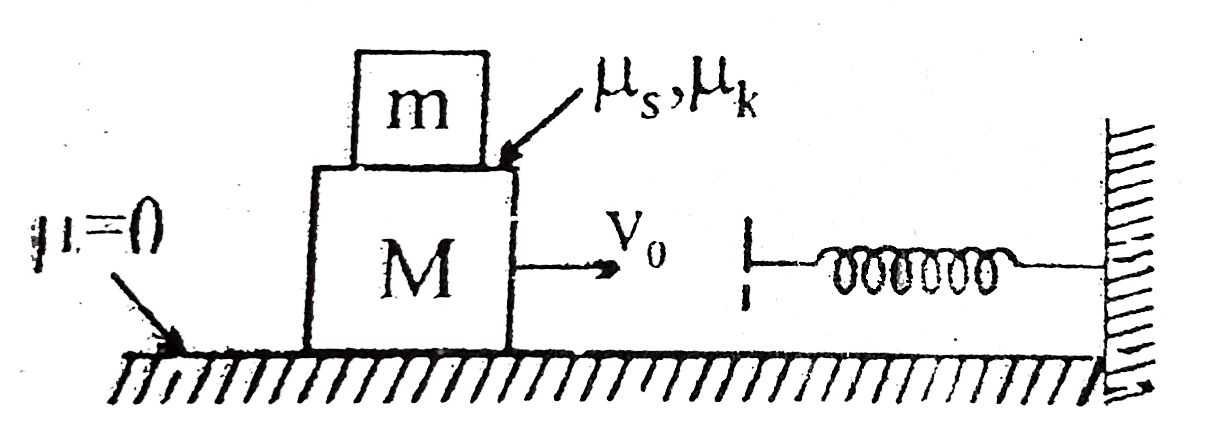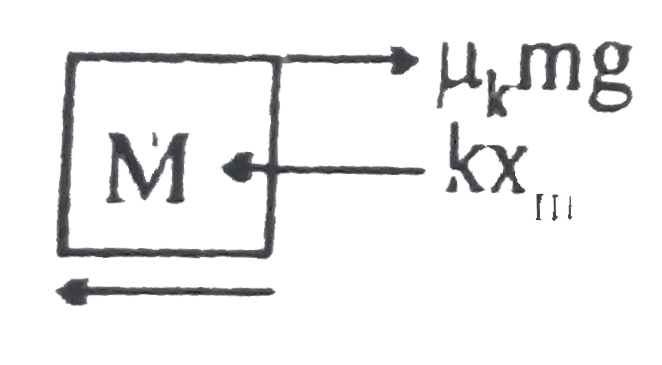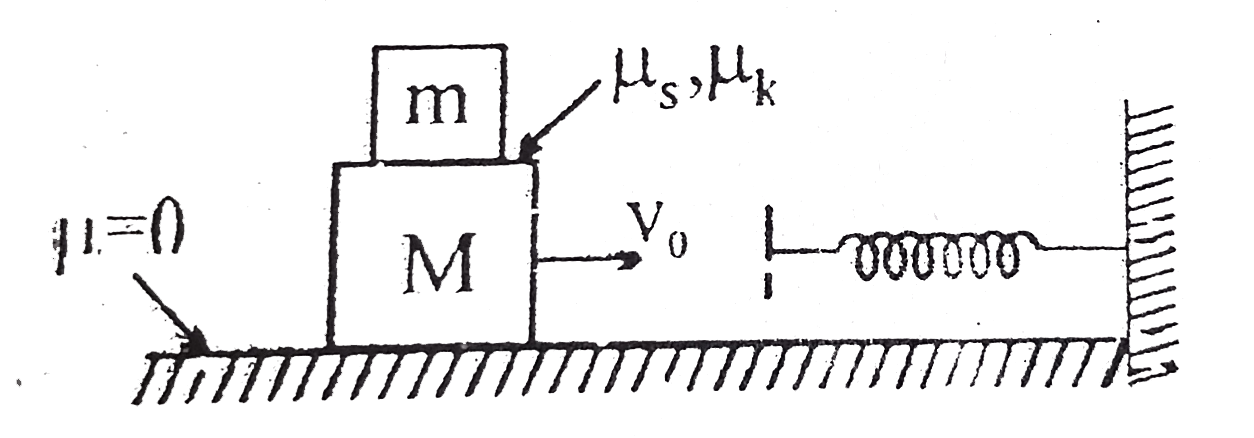A block of mass M slides on a frictionless surface with an initial speed of v0 On top of block is a small box of mass m. the coefficients of friction between box and block are μ6andμk. The sliding block encounters and ideal spring with force constant K. Answer following questions. Suppose the value of k is just slightly greater then the value found in previous question, so that the box begins to slide just as the spring reaches maximum compression. The acceleration of box and block are repectively.

aBox=μkg,aBlock=m(μs−μk)+μsMMg
aBox=(μs−μk)g,aBlock=(μs−μk)mgM
aBox=μkg,aBlock=(μs−μk)mgM
None of these
The correct Answer is:A
aBox=μkg
aBlock=(μs−μk)mgM
aBlock=kxm−μkmgM
=(μs−μk)mgM

Topper's Solved these Questions
- BOOK - BANSALCHAPTER - MASTER PRACTICE PROBLEMEXERCISE - Reasoning75videos
MASTER PRACTICE PROBLEM
- BOOK - BANSALCHAPTER - MASTER PRACTICE PROBLEMEXERCISE - Multiple objective131videos
MASTER PRACTICE PROBLEM
- BOOK - BANSALCHAPTER - MASTER PRACTICE PROBLEMEXERCISE - Additional topic70videos
MASTER PRACTICE PROBLEM
- BOOK - BANSALCHAPTER - FLUID MECHANICSEXERCISE - PYQS AIEEE10videos
FLUID MECHANICS
- BOOK - BANSALCHAPTER - SEMICONDUCTORSEXERCISE - CBSE Question32videos
SEMICONDUCTORS
Similar Questions
Statement-1: The numerical value (n)of a physical quantity is inversely proportional to size of unit (u) being used to measure it.
Statement-2:The magnitude of physical quantity does not change by changing the units.07:41View SolutionThe quantity// quantities that does //do not have mass in its// their dimentions (when we take standard 7 quantities as fundmental) is//are:
03:49View SolutionThe manifestation of band structure in solids is due to
05:03View SolutionA cylinder of height 20m is completely filled with water. The velocity of effux of water (∈ms−1) through a small hole on the side wall of the cylinder near its bottom is
04:48View SolutionHow does the width of the depletion layer of a p-n junction diode change with decrease in reverse bias?
02:25View SolutionThe coefficient of friction between the blocks are mu_(s) = 0.3 and mu_(k) = 0.2 . (a) Find the maximum value of F so that the blocks move together. (b) If force F is twice the value found in (a) , find the acceleration of each block.
View SolutionA block of mass M slides on a frictionless surface with an initial speed of v_(0) On top of block is a small box of mass m. the coefficients of friction between box and block are mu_(6) and mu_(k) . The sliding block encounters and ideal spring with force constant K. Answer following questions. Assuming no relative motion between box and block what is the maximum possible acceleration of block and box at the instant of maximum compression?
View SolutionA block of mass M slides on a frictionless surface with an initial speed of v_(0) On top of block is a small box of mass m. the coefficients of friction between box and block are mu_(6) and mu_(k) . The sliding block encounters and ideal spring with force constant K. Answer following questions. What is maximum value of k for which it remains true that box does not slide?
View SolutionA block of mass m rests on a bracket of mass M. The coefficients of friction between block and bracket are mu_(s) and mu_(k) . The bracket rests on a frictionless surface. What is the maximum force F that can be applied if the block is not to slide on the bracket?
02:53View SolutionA block of mass M is sliding down the plane. Coefficient of static friction is mu_(s) and kinetic friction is mu_(k) . Then friction force acting on the block is :
05:03View SolutionA block of mass M slides on a frictionless surface with an initial speed of v0 . On top of block is small box of mass m . The coefficient of friction between box and block are μs and μk . The sliding block encounters an ideal spring with force constant k . Answer the following questions :

Assuming no relative motion between box and block what is the maximum possible acceleration of block and box at the instant of maximum compression ?05:28View SolutionA block of mass M slides on a frictionless surface with an initial speed of v0 . On top of block is small box of mass m . The coefficient of friction between box and block are μs and μk . The sliding block encounters an ideal spring with force constant k . Answer the following questions :

What is maximum value of k for which it remains true that box does not slide ?06:57View SolutionA block of mass M slides on a frictionless surface with an initial speed of v0 . On top of block is small box of mass m . The coefficient of friction between box and block are μs and μk . The sliding block encounters an ideal spring with force constant k . Answer the following questions :

Suppose the value of k is just slightly greater than the value found in Q.2 , so that the box begins to slide just as the spring reaches maximum compression . The accelerations of box and block are respectively :05:24View SolutionTwo block of masses M and m are connected to each other by a massless string and spring of force constant k as shown in the figure. The spring passes over a frictionless pulley connected rigidly to the egde of a stationary block A. The coefficient of friction between block M and plane horizontal surface of A is mu . The block M slides over the horizontal top surface of A and block m slides vertically downward with the same speed. The mass M is equal to
02:19View SolutionA block of mass M slides on a frictionless surface with an initial speed of v0 On top of block is a small box of mass m. the coefficients of friction between box and block are μ6andμk. The sliding block encounters and ideal spring with force constant K. Answer following questions. What is maximum value of k for which it remains true that box does not slide?
 02:02View Solution
02:02View Solution

